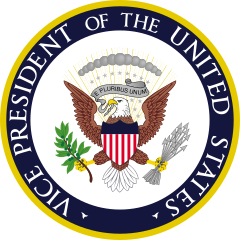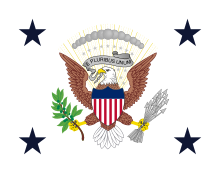Wiceprezydent Stanów Zjednoczonych
 Pieczęć Wiceprezydenta Stanów Zjednoczonych | |
| Stanowisko | |
| Państwo | |
|---|---|
| Data utworzenia | 1789 |
| Pierwszy Wiceprezydent | |
| Długość kadencji | 4 lata |
| Obecny Wiceprezydent | |
| Obecny od | 20 stycznia 2021 |
| Siedziba | |
| Miejsce w sukcesji | Pierwsze |
| Stany ZjednoczoneTen artykuł jest częścią serii: Ustrój i polityka Stanów Zjednoczonych Ustrój polityczny Konstytucja Władza ustawodawcza Władza wykonawcza Władza sądownicza Kontrola państwowa Finanse Samorząd terytorialny Partie polityczne |
Wiceprezydent Stanów Zjednoczonych (ang. Vice President of the United States) – drugi w kolejności najważniejszy urząd polityczny w Stanach Zjednoczonych. Jest wybierany na cztery lata wraz z prezydentem.
W drugiej połowie XX w. poszerzono jego kompetencje. Niektórzy wiceprezydenci nie mieli wpływu na decyzje podejmowane w Białym Domu, niektórzy jednak (np. Al Gore czy Dick Cheney) potrafili je sobie zapewnić.
Byłym wiceprezydentom USA przysługuje dożywotnia emerytura oraz ochrona osobista po odejściu z urzędu.
Wybór wiceprezydenta
Do 1804 r. (wejście w życie 12. poprawki do Konstytucji Stanów Zjednoczonych) wiceprezydentem zostawała osoba, która zajęła drugie miejsce w wyborach na prezydenta. Jednak z uwagi na różnice polityczne, od tego czasu przeprowadza się oddzielne, ale równoległe wybory na wiceprezydenta.
Obecnie jest obierany na cztery lata wraz z prezydentem. Kandydata na ten urząd wskazuje kandydat na prezydenta. Na wiceprezydenta może kandydować osoba, która posiada bierne prawo wyborcze w wyborach prezydenckich.
Sukcesja prezydencka
Wiceprezydent automatycznie (w wyniku sukcesji) zostaje prezydentem w wyniku: śmierci, zrzeczenia się lub usunięcia z urzędu prezydenta. Początkowo działo się to na mocy przyjętego zwyczaju, zanim taki stan rzeczy nie został formalnie usankcjonowany za sprawą uchwalonej w roku 1967 25. poprawki do konstytucji[1].
Tą samą poprawką ustanowiono zapis, zgodnie z którym w razie opróżnienia urzędu wiceprezydenta prezydent jest zobowiązany mianować nowego wiceprezydenta. Wiceprezydent z nominacji obejmuje urząd po zatwierdzeniu przez połączone izby Kongresu[1].
Wakaty na stanowisku wiceprezydenta
W przeciwieństwie do urzędu prezydenta, urząd wiceprezydenta może być nieobsadzony. Do czasu uchwalenia 25. poprawki do konstytucji, w przypadku zwolnienia urzędu prezydenta (który obejmował wiceprezydent) lub w przypadku zwolnienia urzędu wiceprezydenta, urząd ten pozostawał do końca bieżącej kadencji nieobsadzony - nie przewidywano żadnej możliwości uzupełnienia wakatu. Gdyby w takim przypadku doszło do śmierci lub ustąpienia prezydenta, zastosowanie miałaby tzw. linia sukcesji prezydenckiej, ale nigdy nie doszło do takiej sytuacji.
Urząd wiceprezydenta był opróżniony w okresach:
- od 20 kwietnia 1812 r. do 4 marca 1813 r. (George Clinton zmarł),
- od 23 listopada 1814 r. do 4 marca 1817 r. (Elbridge Gerry zmarł),
- od 28 grudnia 1832 r. do 4 marca 1833 r. (John Calhoun zrezygnował),
- od 4 kwietnia 1841 r. do 4 marca 1844 r. (John Tyler został prezydentem),
- od 9 lipca 1850 r. do 4 marca 1853 r. (Millard Fillmore został prezydentem),
- od 18 kwietnia 1853 r. do 4 marca 1857 r. (William de Vane King zmarł),
- od 15 kwietnia 1865 r. do 4 marca 1869 r. (Andrew Johnson został prezydentem),
- od 22 listopada 1875 r. do 4 marca 1877 r. (Henry Wilson zmarł),
- od 19 września 1881 r. do 4 marca 1885 r. (Chester Arthur został prezydentem),
- od 25 listopada 1885 r. do 4 marca 1889 r. (Thomas Hendricks zmarł),
- od 21 listopada 1899 r. do 4 marca 1901 r. (Garret Hobart zmarł),
- od 14 września 1901 r. do 4 marca 1905 r. (Theodore Roosevelt został prezydentem),
- od 30 października 1912 r. do 4 marca 1913 r. (James Sherman zmarł),
- od 2 sierpnia 1923 r. do 4 marca 1925 r. (Calvin Coolidge został prezydentem),
- od 12 kwietnia 1945 r. do 4 marca 1949 r. (Harry Truman został prezydentem),
- od 22 listopada 1963 r. do 4 marca 1965 r. (Lyndon Johnson został prezydentem),
- od 10 października do 6 grudnia 1973 r. (Spiro Agnew zrezygnował, powołano Geralda Forda),
- od 9 sierpnia do 19 grudnia 1974 r. (Gerald Ford został prezydentem, powołano Nelsona Rockefellera).
Wiceprezydenci jako przewodniczący Senatu
Wiceprezydent z urzędu jest przewodniczącym Senatu USA, w głosowaniu bierze jednak udział jedynie w wypadku równego podziału głosów w celu przełamania remisu[2]. Nie prowadzi też obrad na co dzień, zastępuje go przewodniczący pro tempore Senatu.
Głosowania wiceprezydentów w Senacie[2]:
- John Adams – 29
- John C. Calhoun – 28
- George M. Dallas – 19
- Schuyler Colfax – 17
- Richard M. Johnson – 14
- George Clinton – 12
- John C. Breckinridge – 9
- Dick Cheney – 8
- Richard M. Nixon – 8
- Alben W. Barkley – 8
- Thomas R. Marshall – 8
- George H.W. Bush – 7
- Hannibal Hamlin – 7
- William A. Wheeler – 6
- Elbridge Gerry – 6
- Al Gore – 4
- Hubert H. Humphrey – 4
- Henry A. Wallace – 4
- James S. Sherman – 4
- Levi P. Morton – 4
- Martin Van Buren – 4
- John Nance Garner – 3
- Charles Curtis – 3
- Chester A. Arthur – 3
- Millard Fillmore – 3
- Daniel D. Tompkins – 3
- Aaron Burr – 3
- Thomas Jefferson – 3
- Spiro T. Agnew – 2
- Charles G. Dawes – 2
- Adlai E. Stevenson – 2
- Mike Pence – 1
- Walter Mondale – 1
- Harry S. Truman – 1
- Garret A. Hobart – 1
- Henry Wilson – 1
- Joe Biden – 0
- Dan Quayle – 0
- Nelson A. Rockefeller – 0
- Gerald R. Ford – 0
- Lyndon B. Johnson – 0
- Calvin Coolidge – 0
- Charles W. Fairbanks – 0
- Theodore Roosevelt – 0
- Thomas A. Hendricks – 0
- Andrew Johnson – 0
- William R. King – 0
- John Tyler – 0
Wiceprezydenci Stanów Zjednoczonych
Zobacz też
- Number One Observatory Circle, oficjalna siedziba Wiceprezydenta
- prezydenci USA
- pełniący obowiązki prezydenta USA
- precedencja w USA
- wiceprezydent CSA
- Designated survivor
Przypisy
- ↑ a b 25th Amendment (ang.). Cornell University Law School, Legal Information Institute, 2009-11-12. [dostęp 2017-02-09].
- ↑ a b Aaron Bycoffe: Pence Has Already Done Something Biden Never Did: Break A Senate Tie (ang.). FiveThirtyEight, 2017-02-07. [dostęp 2017-02-09].
Linki zewnętrzne
- Oficjalna strona wiceprezydenta USA. whitehouse.gov. [zarchiwizowane z tego adresu (2006-10-24)].
- Dominik Kasprzak – Prezydent Stanów Zjednoczonych. Historia i specyfika amerykańskiego systemu wyborczego
- Strona poświęcona wiceprezydentom amerykańskim
- Oficjalna witryna internetowa Muzeum, Biblioteki i Centrum Dana Quayle’a, jedyne wiceprezydenckie muzeum w USA
Media użyte na tej stronie
Seal of the Vice President of the United States. The blazon is defined in Executive Order 11884 as:
The design is the same as the Seal of the President of the United States, except that there is no ring of stars, the clouds are gray (instead of proper), the stars are gray (instead of argent), the scroll is gray (instead of white), the arrows are gray (instead of proper), and the background colors and inscription (obviously) differ.The Coat of Arms of the Vice President of the United States shall be of the following design:
SHIELD: Paleways of thirteen pieces argent and gules, a chief azure; upon the breast of an American eagle displayed holding in his dexter talon an olive branch proper and in his sinister a bundle of thirteen arrows gray, and in his beak a gray scroll inscribed "E PLURIBUS UNUM" sable.
CREST: Behind and above the eagle a radiating glory or, on which appears an arc of thirteen cloud puffs gray, and a constellation of thirteen mullets gray.
The Seal of the Vice President of the United States shall consist of the Coat of Arms encircled by the words "Vice President of the United States."
The flag of Navassa Island is simply the United States flag. It does not have a "local" flag or "unofficial" flag; it is an uninhabited island. The version with a profile view was based on Flags of the World and as a fictional design has no status warranting a place on any Wiki. It was made up by a random person with no connection to the island, it has never flown on the island, and it has never received any sort of recognition or validation by any authority. The person quoted on that page has no authority to bestow a flag, "unofficial" or otherwise, on the island.
Seal of the Vice President of the United States. The blazon is defined in Executive Order 11884 as:
The design is the same as the Seal of the President of the United States, except that there is no ring of stars, the clouds are gray (instead of proper), the stars are gray (instead of argent), the scroll is gray (instead of white), the arrows are gray (instead of proper), and the background colors and inscription (obviously) differ.The Coat of Arms of the Vice President of the United States shall be of the following design:
SHIELD: Paleways of thirteen pieces argent and gules, a chief azure; upon the breast of an American eagle displayed holding in his dexter talon an olive branch proper and in his sinister a bundle of thirteen arrows gray, and in his beak a gray scroll inscribed "E PLURIBUS UNUM" sable.
CREST: Behind and above the eagle a radiating glory or, on which appears an arc of thirteen cloud puffs gray, and a constellation of thirteen mullets gray.
The Seal of the Vice President of the United States shall consist of the Coat of Arms encircled by the words "Vice President of the United States."
Autor: Ssolbergj, Licencja: CC BY-SA 3.0
The greater coat of arms of the United States of America, as depicted on passports, embassies and the Great Seal.







